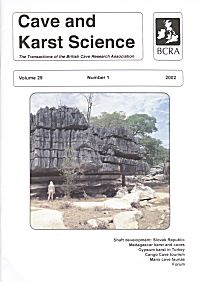
BCRA > Publications > Cave & Karst Science> Contents
Scroll down for Editorial | Papers | Reports | Forum | Thesis Abstracts
 |
Cover photo by John Middleton of dissolution notches and small foot caves beneath a limestone wall with razor-sharp karren, within the Tsingy de Namoroka of western Madagascar |
The Editorial is confined to a discussion of production methods for Cave and Karst Science. Digital techniques are used to produce the camera-ready hard copy, which is supplied, lacking only its photographic illustrations, to the printer. Line illustrations are inserted directly into the DTP files and printed as part of the camera-ready copy. In contrast, photographic illustrations are "dropped into" the camera-ready copy by the printing company. Authors are asked to provide photographic illustrations only if they are of sufficiently high quality to remain interesting and informative after printing. Secondly, if authors wish to provide photographic images digitally, they should ensure that they are properly balanced and of sufficiently high resolution. However, especially in the case of potential cover photos, unless high-quality, high-resolution photo-files are available, good hard copies (print or transparency) are preferred. Otherwise, the various guidelines included inside the front cover continue to apply. Recommendations regarding text on illustrations large enough to allow reduction remain particularly important. Large landscape format figures that need rotating through 90 degrees to present them sideways on a portrait format page are to be avoided - they will inevitably be reduced to fit across the page to be part of the flow of the article, but problems arise if the text is too small to be read if this is done.
This page created by Dr John D. Wilcock, and edited by David Gibson.